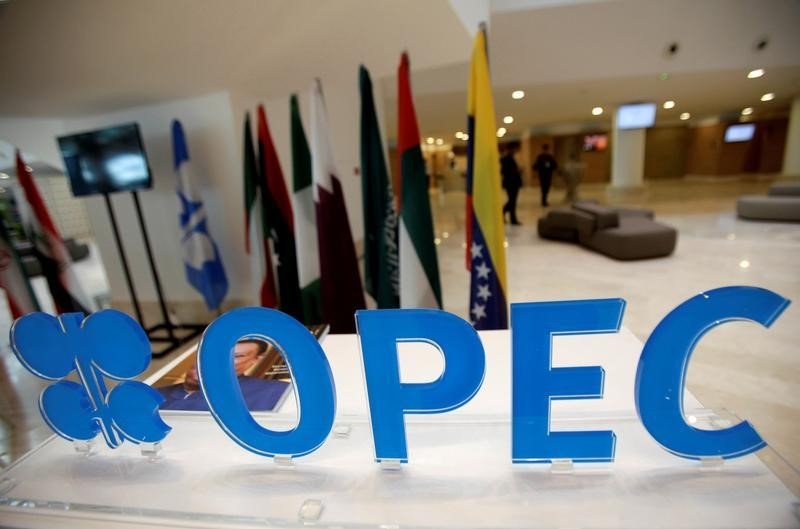Investing
Energy & precious metals – weekly review and outlook

© Reuters.
By Barani Krishnan
Investing.com — The price of a commodity – or for that matter, anything – is invariably subject to supply and demand. In oil’s case, the events of the past three years have shown that supply is probably a greater price influencer than demand.
It was not demand but OPEC’s supply strangle and the sanctions on Russia over the Ukraine invasion that got a barrel to above $100 last year. Likewise, the journey back down to $70 was largely a consequence of the Biden administration releasing more than 200 million barrels from the U.S. reserve, although China’s draconian COVID controls at that time did put a serious damper on demand from the largest crude importer.
Thus, when the Wall Street Journal reported Friday that the United Arab Emirates was having an internal debate about the prospect of leaving OPEC, the bottom suddenly fell out of the oil market for a while.
A decision by the UAE to leave the Organization of the Petroleum Exporting Countries would diminish the oil price-setting powers of the group that accounts for nearly 38% of global output. The Emiratis produce more than 3 million barrels daily and are OPEC’s third most prolific producer.
The Journal said the UAE’s contemplation of an exit came as its discontent over the Yemen war grows with the Saudis – who practically decide on everything at OPEC.
A couple of hours after the story broke, Reuters issued a rebuttal, quoting a UAE official as saying that the Journal’s account of the matter was “far from the truth”.
Crude – which tumbled more than $2.30 a barrel, or 3%, earlier on worries that OPEC might be coming apart at the seams – retraced all losses, ending the day up 2% and the week 4% higher.
“It’s debatable whether we’d have got such a gain on the day if not for that Journal story,” said John Kilduff, partner at New York energy hedge fund Again Capital. “You know how it is; the bull fervor that usually follows the denial of something that’s negative to the market.”
“Fundamentally, it was a positive week for oil with data showing record U.S. crude exports and an uptick in gasoline demand,” Kilduff said. But the affirmation of OPEC’s status was what gave the bulls the trigger for a rally, he said. “It reinforces the notion that more than China demand, it’s OPEC supply – or cuts – that’s holding the oil market where it is,” Kilduff said, referring to the two million barrels per day the cartel has been keeping off the market since October.
The Journal story was grounded more in politics than in oil. It gave a lengthy explanation as to why the UAE would want to leave OPEC, saying relations between its president Sheikh Mohammed bin Zayed al Nahyan and Saudi Crown Prince Mohammed bin Salman had soured, with the two men deliberately avoiding each other at public events in the Gulf.
It said the rift actually began with oil, in mid-2021, over the Saudis’ insistence on production cuts for all of OPEC when the Emiratis wanted to turn their spigots on fully to capitalize on demand rebounding after the worst had passed with the coronavirus pandemic.
The Yemen war played a part in the feud too, with the UAE hoping to keep its influence in the country to secure shipping routes in the Red Sea. The Saudis, meanwhile, had been having talks with Houthi rebels – without the UAE – in hopes of ending the war. The UAE has signed a security agreement with the Saudi-backed Yemeni government that allows them to intervene if there is an imminent threat – and they’re looking to build a military base and runway in the Bab el-Mandeb strait. But Saudi officials have privately objected to this agreement, the Journal said.
That political events in the Gulf aren’t going the way of the UAE is obvious. There’s a lot at stake here and it’s understandable why one might extend that to the narrative of a potential OPEC exit by the country.
Yet, the fact of the matter is this: the UAE needs OPEC as much as OPEC needs the UAE.
The term OPEC here is interchangeable with Saudi Arabia because that’s really what it is in the context of oil: No nation within OPEC would want to quit the group now when its influence over the market is at its greatest since the Oil Embargo of the ’70s.
The unity within OPEC – it’s funny to call it that when the Iranians, Saudis and Emiratis all have knives behind each others’ backs – is what leads to the group’s compliance on production cuts and translates to its price-setting power. It’s hard to think of any producer who would want to be out of this arrangement now simply to turn out more barrels. The risk of being isolated or – worse – planting the seeds of OPEC’s collapse is just unimaginable for any member or ally.
Oil: Market Settlements and Activity
New York-traded did a final trade at $79.85 on Friday, after officially settling the session at $79.68 a barrel, up $1.52, or 1.9%, on the day. For the week, the U.S. crude benchmark gained 4.4%.
London-traded did a final trade of $86. It settled at $85.83, up $1.08, or 1.3%. The global crude benchmark rose 3.7% on the week.
Crude prices started the week with a stumble, then gained momentum on positive factory data from top oil importer China.
Hawkish rate hike talks and inflation concerns kept the market from breaking out after the Energy Information Administration reported on Wednesday that U.S. crude exports hit a record high of 5.629 million barrels last week.
Friday’s session was again volatile as prices initially tumbled on the Journal report about a potential UAE exit from OPEC. By midmorning though, the market had retraced the losses after another report by Reuters rebutted the Journal story.
Notwithstanding Friday’s runup, crude prices look set to stay in a range, with WTI likely to be boxed between $75 and $80, said Craig Erlam, analyst at online trading platform OANDA.
“Prices have fluctuated in a range for months now and the current price sits more-or-less in the middle of that range. While traders are becoming more optimistic about the Chinese recovery, the risks to the global economy may be increasing as interest rate expectations have risen,” said Erlam. “The range does appear to be gradually tightening but remains quite large and there appears little appetite for a breakout at this moment in time.”
Downside risks could escalate again in the coming week when the Labor Department releases the U.S. non-farm payrolls report for February. The employment report is expected to show a slower jobs growth of 215,000 for last month after the blowout 517,000 in January.
“U.S. jobs numbers have surprised to the upside month after month and there’s a chance that February could give us another jolt,” said Kilduff. “If that’s the case, rate expectations will be skewed to the upside again, and risk assets will suffer. Oil is certainly not out of the woods.”
Oil: Price Outlook
WTI needs to establish above $79.90 next week to clear through major resistance of $80 and above, said Sunil Kumar Dixit, chief technical strategist at SKCharting.com.
“The first line of resistance is at $80.60, followed by $81.90, which if confirmed, would pave the way for a further upside toward the 100-week SMA, or Simple Moving Average of $84.10,” said Dixit.
But there’s also the possibility of a price rejection from $80.60 that could push WTI back toward the support zone of $76.50, he said.
Natural gas: Market Settlements and Activity
Natural gas futures rose 23% on the week to return to the critical $3 pricing after a 2-½-month long selloff that took the market to $1 territory.
The April gas contract on the New York Mercantile Exchange’s Henry Hub did a final trade of $3.016 on Friday. It settled the session at $3.0090 per mmBtu, or million metric British thermal units. That was up 24.4 cents, or 9%, on the day. For the week, it rose 55.8 cents.
It was also the first time since Jan. 24 that a front-month contract on the Henry Hub settled above the $3 mark, after gas futures lost the $2 perch amid intense selling sparked by an abnormally warm winter.
The rebound in gas prices comes on the back of late winter chills expected across the United States, which has less than three weeks left before the official start of spring.
Natural gas: Price Outlook
Natural gas futures are showing a tendency of being able to progress from their takeout of the $3 barrier, with major indicators RSI and Stochastics all strongly positioned on weekly charts, supporting the rebound, said SKCharting’s Dixit.
“In contrast, the 4-Hour time frame of RSI at 82 has reached overbought conditions, calling for some pullback towards the support area of $2.77, followed by $2.66,” he said. “If there’s any weakness below the $2.77 – $2.66 support zone, expect a drop towards $2.50.”
On the way up, immediate resistance is seen at $3.18 and $3.26 before the 50-Day EMA, or Exponential Moving Average, of $3.30.
“If the above-mentioned resistance levels are decisively cleared, gas bulls will take aim at $3.55 before the critical barrier, representing the 200-week SMA of $3.75,” he added.
Gold: Market Settlements and Activity
Gold for on New York’s Comex did a final trade of $1,862.80 on Friday. It earlier settled the official session at $1,854.60 an ounce, up $14.10, or 0.8%, on the day. For the week, the benchmark gold futures contract rose $45.40, or 2.5%.
The , more closely followed than futures by some traders, settled at $1,856.43 on Friday, up $20.69, or 1.3% on the day.
Gold: Price Outlook
If gold decides to rebalance overbought conditions on a 4-hour time frame, it can experience a pullback to $1,850, which if breaks below, could reach towards the support areas of $1,845 – $1,838, said Dixit of SKCharting.
“If there is further correction below $1,838, expect a retest of the $1,835 – $1,830 range,” he said.
“On the way up though, gold has upside potential towards $1,865,” said Dixit. “Next would be $1,876, which marks the 200-SMA on the 4-Hour chart and the 23.6% Fibonacci level at $1,879.”
Disclaimer: Barani Krishnan does not hold positions in the commodities and securities he writes about.
Read the full article here

-

 Side Hustles5 days ago
Side Hustles5 days agoKickstart Your Year With These Entrepreneurial Health Checkups
-

 Side Hustles4 days ago
Side Hustles4 days agoExpand Your Global Reach with Access to More Than 150 Languages for Life
-

 Side Hustles3 days ago
Side Hustles3 days agoKFC Announces Saucy, a Chicken Tenders-Focused Spinoff
-

 Investing3 days ago
Investing3 days agoPalantir, Anduril join forces with tech groups to bid for Pentagon contracts, FT reports By Reuters
-

 Side Hustles4 days ago
Side Hustles4 days agoThis AI is the Key to Unlocking Explosive Sales Growth in 2025
-

 Side Hustles2 days ago
Side Hustles2 days ago4 Ways Content Can Make or Break the Customer Experience
-

 Passive Income6 days ago
Passive Income6 days ago5 Key Success Factors of Thriving Entrepreneurs
-

 Passive Income5 days ago
Passive Income5 days agoHow to Motivate, Inspire and Energize Your Employees


















